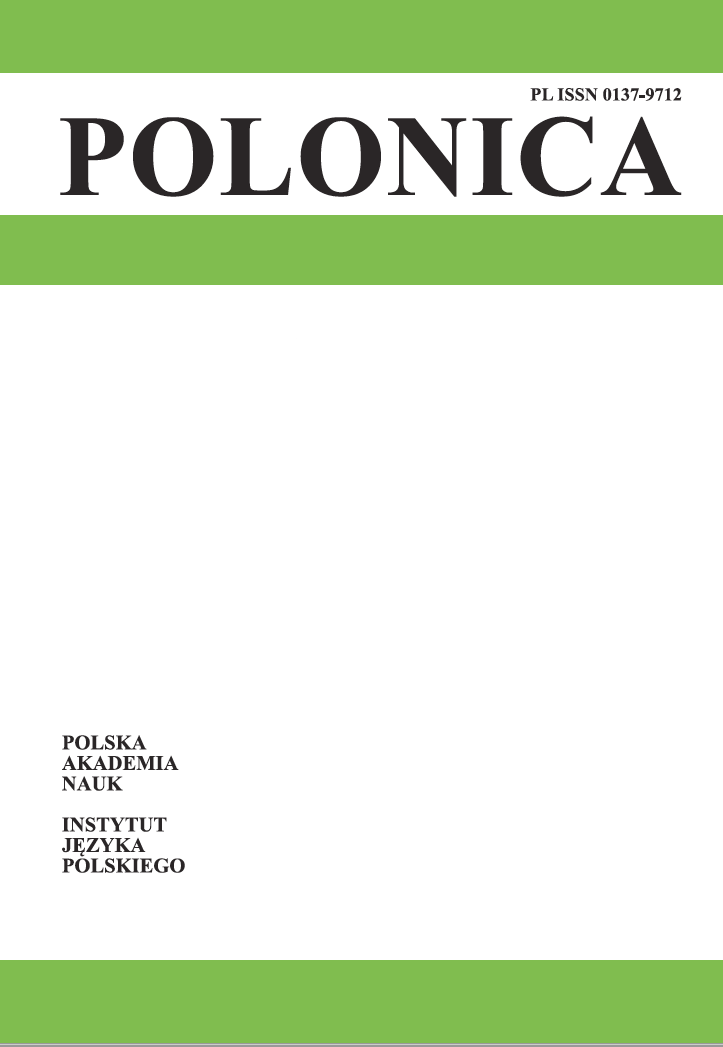Abstract
The article discusses Metaphor Identification Procedure Vrije Universiteit (known as MIPVU, Steen et al. 2010) as a method that can be systematically applied to localize metaphorical expressions in discourse. Apart from outlining the steps of the procedure, we focus on the theoretical assumptions underlying its origin as well as point at some benefits and difficulties arising during its application to English and Polish data. The primary aim of the article is to present MIPVU as an attempt at creating a reliable and replicable metaphor identification method that can be used in different text types and different languages.
References
Badryzlova J. i in., 2013, Annotating a Russian corpus of conceptual metaphor: a bottom-up approach, [w:] Proceedings of the First Workshop on Metaphor in NLP, Atlanta: Association for Computational Linguistics, s. 77–86
Bralczyk J. i in., 2005, Słownik języka polskiego PWN, http://sjp.pwn.pl.
Cameron L., 2003, Metaphor in Educational Discourse, London.
Cameron L., Deignan A., 2003, Combining large and small corpora to investigate tuning devices around metaphor in spoken discourse, Metaphor and Symbol 18/3, s. 149–160.
Dobrzyńska T., 1994, Mówiąc przenośnie...: studia o metaforze, Warszawa.
Fleiss J. i in., 2003, Statistical Methods for Rates and Proportions, Hoboken, N.J.
Forceville Ch., 1996, Pictorial Metaphor in Advertising, London–New York.
Goatly A., 1997, The Language of Metaphors, London–New York.
Górska E., 2010, LIFE IS MUSIC: A case study of a novel metaphor and its use in discourse, [w:] Textual Choices in Discourse: A view from Cognitive Linguistics, red. B. Dancygier, J. Sanders, L. Vande la - notte, Amsterdam, s. 137–155.
Juszczyk K., Kamasa V., 2016, Ku metodzie identyfikacji wyrażeń metaforycznych dla polszczyzny na przykładzie rozmów o karierze zawodowej, Język a Komunikacja 37, s. 177–186.
Krippendorf K., 2004, Content analysis: an introduction to its methodology, New York.
Lakoff G., Johnson M., 1980, Metaphors We Live By, Chicago.
Marhula J., 2015, Metaphor in Spoken Discourse. Towards Characterization of Tuning Devices in Radio Talk. A Case Study of BBC Radio 4 Woman’s Hour, Rozprawa doktorska, Uniwersytet Warszawski.
Marhula J., Rosiński M., 2014, Identifying metaphor in spoken discourse: insights from applying MIPVU to radio talk data, Studia Anglica Resoviensia 11, s. 32–43.
Müller C., 2008, Metaphors Dead and Alive, Sleeping and Waking, Chicago.
Pasma T., 2012, Metaphor identification in Dutch discourse, [w:] Metaphor in use, red. F. MacArthur, J. Oncins-Martínez, M. Sánchez-García, A. Piquer-Píriz, Amsterdam–Philadelphia, s. 69–83.
Pragglejaz Group, 2007, MIP: A method for identifying metaphorically used words in discourse, Metaphor and Symbol 22/1, s. 1–39.
Przybylska R., 2002, Polisemia przyimków polskich w świetle semantyki kognitywnej, Kraków.
Reijnierse G., 2010, Making MIP operational for French. Practical and theoretical issues concerning the choice of a dictionary, RaAM 10 Conference, Vrije Universiteit, Amsterdam.
Rundell M. (red.), 2002, Macmillan English Dictionary for Advanced Learners, Oxford.
Steen G., 2007, Finding Metaphor in Grammar and Usage, Amsterdam–Philadelphia.
Steen G. i in., 2010, A Method for Linguistic Metaphor Identification, Amsterdam–Philadelphia.
Tay D., 2011, Discourse markers as metaphor signalling devices in psychotherapeutic talk, Language & Communication 31, s. 310–317.
Urbonaitѐ J., 2015, Metaphor identification procedure MIPVU: an attempt to apply it to Lithuanian, Taikomoji kalbotyra 7, s. 1–26.
Zawisławska M., 2004, Metafora w języku nauki: na przykładzie nauk przyrodniczych, Warszawa.
